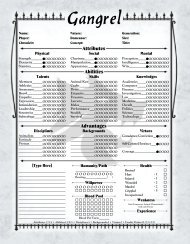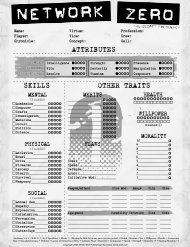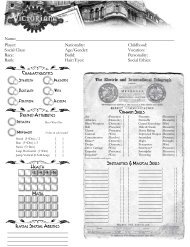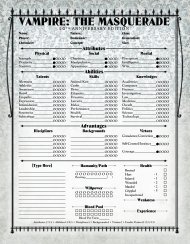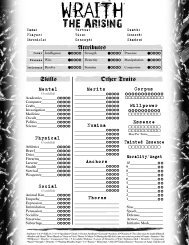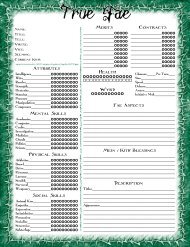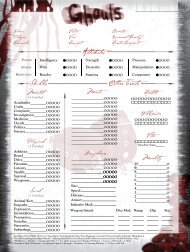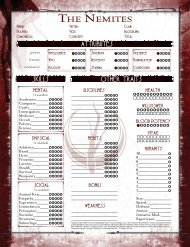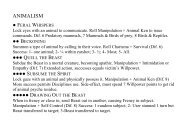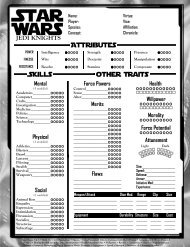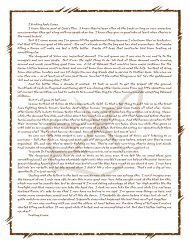Vampire: the Middle Kingdom - MrGone's Character Sheets
Vampire: the Middle Kingdom - MrGone's Character Sheets
Vampire: the Middle Kingdom - MrGone's Character Sheets
Create successful ePaper yourself
Turn your PDF publications into a flip-book with our unique Google optimized e-Paper software.
Spirits<br />
Here are some basic rules for spirits, supplementing material found on pgs. 210-217 of Kindred of <strong>the</strong> East. I've taken<br />
liberties with <strong>the</strong> mechanics and terminology a bit to streamline <strong>the</strong> system, eliminate redundancy, and reflect a more Eastern feel for<br />
<strong>the</strong> spirits. Both Yang-spirits and Yin-spirits are described with <strong>the</strong> same basic mechanics and traits. (Yin-spirits are better described<br />
in terms of Attributes, Skills, Pathos and Arcanoi, but since I've not gotten around to converting Wraith: <strong>the</strong> Oblivion to <strong>the</strong> new<br />
mechanics yet, <strong>the</strong>se simplified rules should work well in a <strong>Vampire</strong>: <strong>the</strong> <strong>Middle</strong> <strong>Kingdom</strong> context).<br />
Forgive <strong>the</strong> homebrew stuff; <strong>the</strong> spirit list needed some fleshing out.<br />
Spirit Traits<br />
Hun: Hun is <strong>the</strong> spirit's higher, rational nature, and serves as <strong>the</strong> default Mental and Social Attribute for spirits; in any roll<br />
that would call for one of those Attributes, roll Hun instead. This trait also functions as <strong>the</strong> spirit's Willpower, and temporary Hun<br />
points may be spent to add extra dice to rolls and resistance traits in precisely <strong>the</strong> manner Willpower points are. Any roll that doesn't<br />
involve <strong>the</strong> P'o defaults to <strong>the</strong> Hun.<br />
P'o: P'o is <strong>the</strong> spirit's ability to attack and harm spirits and o<strong>the</strong>rs, and measures its spiritual strength and “physical” presence;<br />
a high P'o doesn't necessarily indicate wickedness, though that's often <strong>the</strong> case. P'o is used in any roll a Physical Attribute would be<br />
used for, including attack rolls and Defense. Spirit attacks typically do lethal damage, with exceptions noted o<strong>the</strong>rwise. Defense in<br />
this context means a spirit's ability to protect itself; a demon with a high P'o might be very quick, or have thick armor plating that<br />
deflects blows. Similarly, while spirits may carry weapons or display fearsome natural weapons, <strong>the</strong>se are reflections of those beings'<br />
aggressive natures, and offer no bonus to <strong>the</strong> P'o roll when an attack is made – <strong>the</strong> P'o rating takes such armaments into account.<br />
Yin and Yang: Most spirits have ei<strong>the</strong>r a Yin and Yang ratings, with <strong>the</strong> Virtue reflecting its nature: so Yang-spirits have<br />
Yang, naturally. The Virtue is a rough measure of <strong>the</strong> spirit's power, and indicates its status among its kind: a Yin 8 ghost has more<br />
“rank” than a Yin 4 one, and has considerably more power to call upon. It's very rare, though perhaps not entirely unheard of, for a<br />
spirit of one Mirror World to have a rudimentary rating in <strong>the</strong> opposing Virtue. Demons from <strong>the</strong> Yama Hells usually have ratings in<br />
both Virtues.<br />
Chi: Chi serves <strong>the</strong> dual function as a spirit's Health and as a power reservoir for Arts; Chi is lost as <strong>the</strong> spirit spends it, and<br />
as it is attacked and damaged. Spirits don't differentiate between bashing and lethal damage; aggravated is a special case, as spirits<br />
destroyed by such are often destroyed permanently (see below). Damage penalties don't apply to lost Chi. Chi is usually Yin or Yang,<br />
depending on <strong>the</strong> nature of <strong>the</strong> spirit; <strong>the</strong> maximum Chi rating of a spirit is equal to its [Virtue rating x 5]. Some rare spirits, like<br />
demons hailing from Yomi Wan, have both Yin and Yang Chi; <strong>the</strong>se spirits will always have both ratings in Yin and Yang, with Chi<br />
reservoirs to match; damage inflicted on <strong>the</strong> spirit is split evenly between its Chi pools, unless an attack targets one or <strong>the</strong> o<strong>the</strong>r.<br />
Derived Stats: Defense = Hun or P'o (whichever is lower); Initiative = Hun or P'o (whichever is higher); Speed = [Hun + P'o].<br />
Tasks<br />
• Actions: Spirits can only act once per turn to attack, defend, move, or use an Art.<br />
• Communication: Yin-spirits can speak <strong>the</strong> languages <strong>the</strong>y could when <strong>the</strong>y were alive, while Yang-spirits are often less<br />
communicative; some know <strong>the</strong> speech of men, but most don't bo<strong>the</strong>r and instead rely on <strong>the</strong> exchange of concepts and<br />
ideas in <strong>the</strong> “tongue” of spirits. Many denizens of <strong>the</strong> Thousand Hells, especially P'o-spirits, speak human languages. In<br />
any case that a spirit is intelligent enough to communicate, a Kuei-jin can communicate with any spirit with a successful<br />
Hun roll (as described under that Virtue, pg. 7 of this document).<br />
• Reincorporation: Normally, when a spirit is destroyed by reducing its Chi to zero, it's absorbed into <strong>the</strong> Tapestry where<br />
it recovers slowly; during this time, it can't be summoned, attacked, communicated with or affected in any way. After a<br />
number of hours equal to 30 minus Hun, it reforms in a safe area with 1 Chi; Yin-spirits always reincorporate at a Fetter<br />
(an object of great personal significance while it was living). A spirit taken to zero Chi by aggravated damage must<br />
make a Hun roll; failure indicates it's destroyed permanently, while success allows it to reincorporate after double <strong>the</strong><br />
normal time.<br />
• Movement: Many spirits float or fly through <strong>the</strong> Mirror lands, though o<strong>the</strong>rs resort to more standard forms of locomotion<br />
like walking or running. Spirits use Speed to determine <strong>the</strong>ir rate of movement.<br />
Nushi Cost: If a spirit is appropriate for use as a Nushi, one can calculate <strong>the</strong> Nushi cost by averaging its Hun, P'o, Yin and<br />
Yang, and <strong>the</strong>n using that figure as a base. A distant spirit, or one unable to offer much in <strong>the</strong> way of benefits to its supplicants, can<br />
offer a slight break on <strong>the</strong> cost; meanwhile, a spirit that offers its wu potent advantages (especially those that are continually active)<br />
would increase <strong>the</strong> nushi cost by 1, 2 or even more.<br />
Streng<strong>the</strong>ning Nushi Spirits: By investing time and energy in honoring a spirit, it wu gives it power. In short, players can<br />
invest <strong>the</strong>ir exp in <strong>the</strong>ir nushi, improving its power, and in turn <strong>the</strong>mselves (as <strong>the</strong> spirit is able to offer more benefits). Exp can be<br />
used to increase Hun, P'o, Yin or Yang as a cost of [new rating x 2]; if <strong>the</strong> spirit lacks ei<strong>the</strong>r Yin or Yang, <strong>the</strong> first dot can be purchased<br />
for 10 exp. New arts cost 5 exp apiece. Finally, buying new benefits – or improving existing ones – should cost from 5 to 10 exp<br />
(scaling with <strong>the</strong> potency of <strong>the</strong> boon), or “buying off” behavioral restrictions; <strong>the</strong> cost is up to <strong>the</strong> Storyteller, who decides ultimately if<br />
such modifications are even possible.


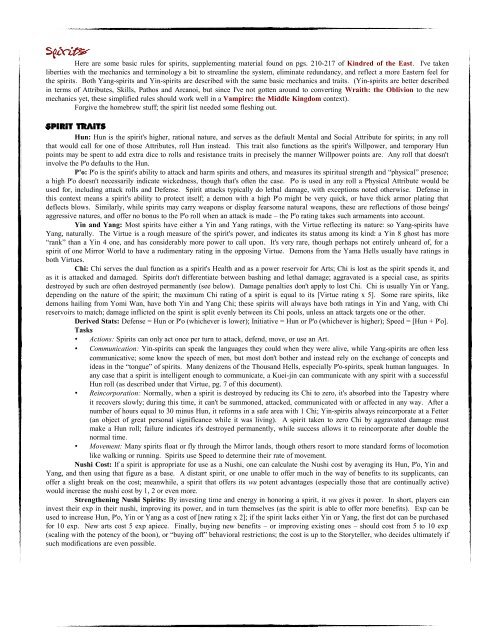
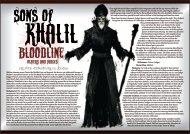
![Interactive Werewolf The Forsaken 4 Page Sheet Version 2[B&W]](https://img.yumpu.com/18249805/1/190x247/interactive-werewolf-the-forsaken-4-page-sheet-version-2bw.jpg?quality=85)

